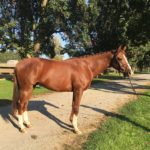The Thoroughbred is our American tradition, and those of us who cherish that tradition are still trying to find ways to protect it.
First, I want to commend those who have done a great job building awareness of the OTTB/Jockey Club Classes. I understand where your heart is, BUT since those classes and incentives have been offered, where exactly has it gotten us? In my mind, through no fault of those who organized those classes, the trainers are the ones who have played a big role in this lack of development.
This brings us to the second part of the equation, where we have to look at ourselves and how the vicious cycle unfolds: Why should a trainer put the proper time into a Thoroughbred if the judges will not give the horse a ribbon? Then how do you convince an owner to buy a Thoroughbred when the resale value is less than half of a warmblood’s value and, hey, you might not get pinned anyway?
A trainer might run the financial risk of “time is money.” If I put my time into a 3-year-old warmblood, in three years I’ll have a nice green prospect or young jumper. However, if I put my time into a 3-year-old Thoroughbred, well, his first year I’ll be detoxing, losing racing muscle and putting weight on the athlete someone created—so by the time three years have gone by, I’ll be lucky to get back what I paid in feed and care.
This is where we find our biggest glitch with the vast majority of the Thoroughbred market. In no way am I trying to say that I do not think the Thoroughbred cannot compete. I know better because of the brilliant few that have slipped through the negativity and risen to the top. What I’m saying is that there is a window of time when the majority of these horses get pulled off the track, are trained or repurposed quickly in order to make a profit, and then moved along.
However, six out of 10 times, because they are inexpensive, they are with people who are not working with a trainer and they do not get professional rides. Then the horse resurfaces as “just another one of those Thoroughbreds.”
Nearly all the Thoroughbreds I see lack the absolute basic concepts of training, and I get it, truly I do. When I pick up the reins and ask for contact, what do you think that means to a Thoroughbred at first? To maintain softness and stay supple through the head and neck and allow me to ride from my leg? Not really. The battle of re-schooling these horses is one thing that we as trainers have to work out somehow, and I believe we should not look to the European model of training, but instead revisit our roots in the American style of riding and training that was developed solely for this breed.
[PHOTOGALLERY uniquename=”galleria-azur”]
I think we all respect George Morris and his love of the Thoroughbred as a sport horse. And if you’re anything like me, you live by the American style of riding he has helped encourage and develop. But we need more people like Morris to help those of us on a grassroots level get the training and the support from people like himself. We need voices and action; no one wants to hear what was true 20 years ago.
I know positively that I am not the only crusader, and I know there are others in the hunter/equitation/jumper world that are doing a fantastic job—but how do we change the minds of those around us?







